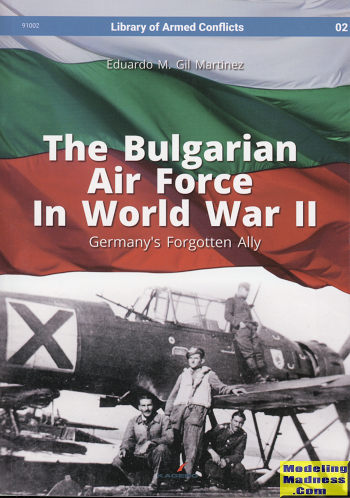Kagero's Bulgarian Air Force in WWII
|
Author: |
Eduardo M Gil Martinez |
|
Publisher |
Kagero |
|
Price |
$22.95 from
Casemate Publishing |
|
Reviewer: |
Scott Van Aken
|
|
Notes: |
#91002. ISBN
978-83-65437-55-6, 120 pages, 110 illustrations,7x10, softcover |
 Some of
Germany's partners in WWII were relatively unwilling to join the Axis. One of
these was Bulgaria. However, Germany needed to be able to travel freely through
the country in order to pursue its war in the Balkans. There was a great deal of
intrigue concerning the Bulgarian king, but eventually, the promise of the
return of territory taken after WWI and German military equipment brought the
king around.
Some of
Germany's partners in WWII were relatively unwilling to join the Axis. One of
these was Bulgaria. However, Germany needed to be able to travel freely through
the country in order to pursue its war in the Balkans. There was a great deal of
intrigue concerning the Bulgarian king, but eventually, the promise of the
return of territory taken after WWI and German military equipment brought the
king around.
The Bulgarian Air Force itself was one of
those that ceased to exist after WWI, thanks to the Paris Treaty, but was
eventually brought back into being in the mid 1930s. It consisted originally of
some locally designed aircraft as well as those from other nations, particularly
Poland when it came to offensive types. Germany did supply some obsolete types
such as Do-11 bombers and Ar-65 fighters, but nothing really modern.
Eventually, the need to have the
Bulgarian Air Force a viable force to help protect the country from USAAF
bombing in 1943 resulted in supplying them with more modern types. Many of these
were used against the Germans in late 1944 when they joined the Soviets and were
used into the late 1940s until replaced by Soviet equipment.
The author relies heavily on the work of
other researchers to help tell this story. I also had some difficulty following
things as he is not a native English speaker and did not have the book
proof-read by someone who was. It results in some odd sentence structure that
can take the reader by surprise.
Basically, a goodly amount of background
is provided as well as a year by year development of the Bulgarian AF. This
includes unit organization as well as efforts to get new equipment. Bulgaria had
a fairly advanced aviation industry and produced many secondary types such as
trainers and recce aircraft. The second major section of the book is on the
different types with areas covering fighters, bombers, transports and such.
There are a lot of period photos of the
men and aircraft involved as well as some very nicely done color profiles. It
may be that there is a dearth of BAF photos as I found about a half dozen very
commonly seen images of US airplanes included. I'd rather have seen more
Bulgarian types.
Overall, it is a worthwhile book, despite
having a few rough edges as mentioned. This is one air arm that has had very
little information available on it and for those interested in the smaller Axis
partners, it is a book that does deserve to be on your shelf.
November 2017
My thanks to Casemate Publishing for the review sample. Visit them at
Casemate Publishing and order yours, or get them at
your favorite hobbyist.
If you would like your product reviewed fairly and
fairly quickly, please contact
me or see other details in the
Note to
Contributors.
 Some of
Germany's partners in WWII were relatively unwilling to join the Axis. One of
these was Bulgaria. However, Germany needed to be able to travel freely through
the country in order to pursue its war in the Balkans. There was a great deal of
intrigue concerning the Bulgarian king, but eventually, the promise of the
return of territory taken after WWI and German military equipment brought the
king around.
Some of
Germany's partners in WWII were relatively unwilling to join the Axis. One of
these was Bulgaria. However, Germany needed to be able to travel freely through
the country in order to pursue its war in the Balkans. There was a great deal of
intrigue concerning the Bulgarian king, but eventually, the promise of the
return of territory taken after WWI and German military equipment brought the
king around.